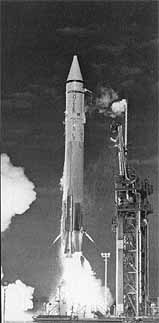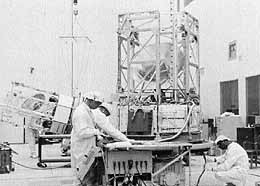















|
 |
Mariner F and G spacecraft (below)-to be christened Mariner 6 and 7 on launch-are tested in preparation for their five-moth journeys to Mars to investigate the planet's atmosphere and surface. Solar arrays are not yet installed. At left, an Atlas-centaur launch vehicle thrusts Mariner 7 toward space from Cape Kennedy, Florida, on 27 March 1969, following the Mariner 6 launch in February. |
 |
| ||
|
| ||
|
|
|
|
|
|
|
|
|
Shape |
Octagonal magnesium frame |
Octagonal magnesium frame |
|
Size |
127 cm diagonal; 45.7 cm depth |
127 cm diagonal; 45.7 cm depth |
|
Solar panels |
112 cm x 90 cm (4); 4.0 sq m |
112 cm x 90 cm (4); 7.7 sq m |
|
Launch weight |
412.8 kg |
997.9kg |